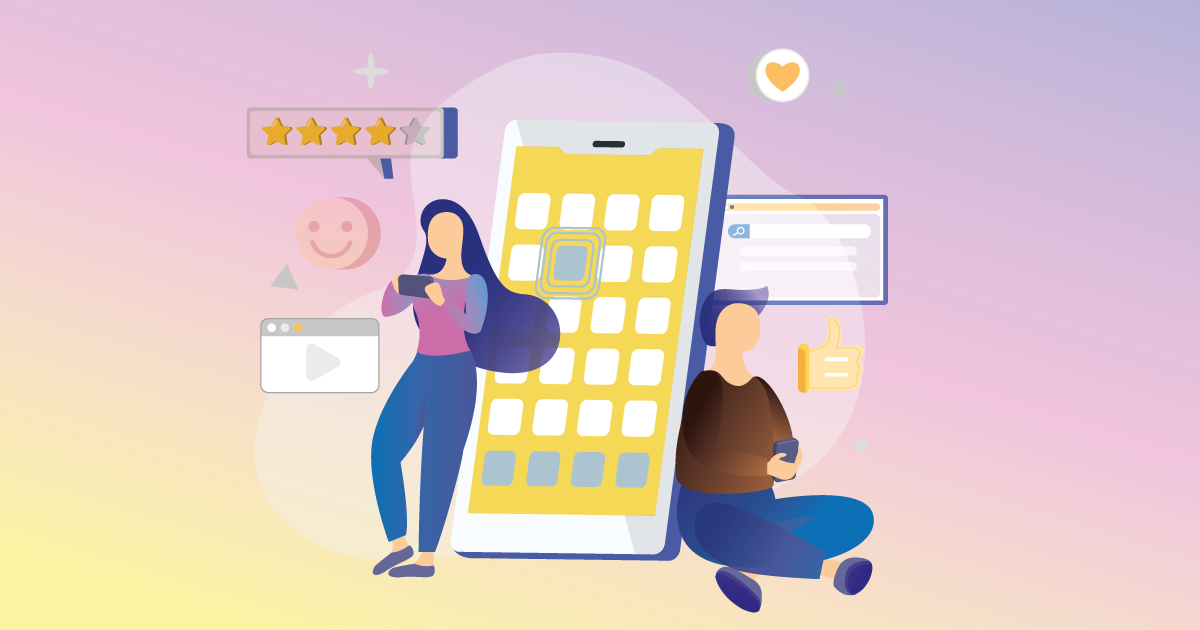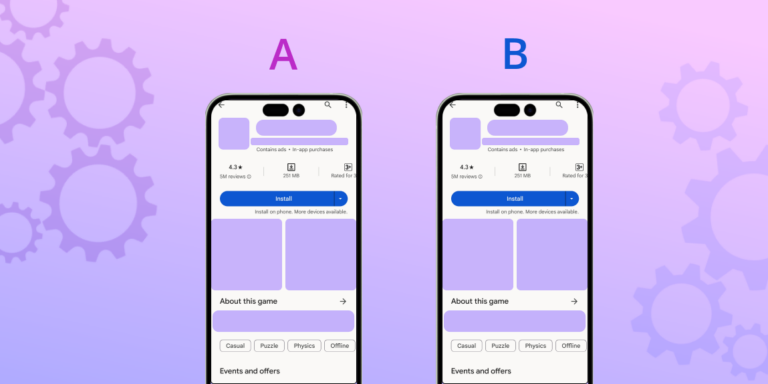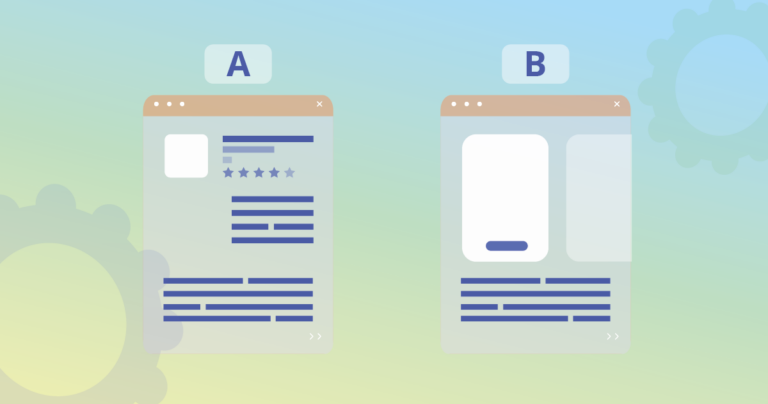‘A website without conversion rate optimization is like a car with no wheels — it will take you nowhere.’ This profound statement by Jeremy Abel, the chief strategist at rDialogue, underscores the fundamental importance of conversion rate optimization (CRO) in today’s digital landscape. However, CRO is not confined solely to web domains. It seamlessly transcends into the niche of mobile apps.
Mobile app optimization, often called App Store Optimization (ASO), echoes the same sentiment. In both SEO and ASO, enhancing conversion rates is the foundation for success. In this specific article, we will delve deep into the dynamic dimensions of mobile app conversion rate, exploring industry benchmarks and providing actionable insights to boost your app’s performance.
Upon finishing reading this post, you will learn:
- why all the hype about mobile conversions in the first place;
- what App Conversion Rate is;
- about its specifics and importance;
- 8 expert-provided reasons why App Conversion Rate is so important;
- what a good App Store Conversion Rate is;
- how to calculate App Conversion Rate;
- about 3 app store conversion rate types and how to work with each of them;
- about the game-changing conversion rate: install to value;
- 10 more bonus tips for taking your App Conversion Rate to the next level.
Whether you’re an experienced app developer or a newcomer to the field, this comprehensive guide will equip you with the knowledge and tools needed to confidently navigate the ever-evolving domain of mobile app conversion. Join us on this journey to unveil the key metrics, strategies, and best practices that can propel your mobile app to new heights of engagement and profitability. Stay tuned.
Table of Contents
Why All the Hype?
Mobile eCommerce is experiencing explosive growth these days. With a staggering 7.33 billion mobile users and a rising tide, this trend is here to stay. Currently, over 60% of business owners worldwide engage and sell to customers through mobile devices, and this figure is set to rise. We’ll provide more facts to justify the app conversion hype when defining app conversion rate benchmarks down below.
Despite these promising statistics and trends, a significant number of eCommerce brands we work with express a common dilemma. They find it incredibly difficult to replicate their desktop success with mobile app conversions. If you’re facing similar obstacles to marketing your app to the stars, the tips and insights we offer below are right up your street.
What Is App Conversion Rate?
App Conversion Rate (often shortened to ACR) is a crucial metric on the mobile app performance measurement scene. It represents the percentage of users who take a desired action within an app or an app store, ultimately reflecting the app’s effectiveness in converting casual users into engaged and valuable paying customers.
A high ACR signifies that the app is adept at guiding users through the desired user journey, whether installing an app, purchasing a subscription, signing up for a newsletter, or achieving any other predefined goal.
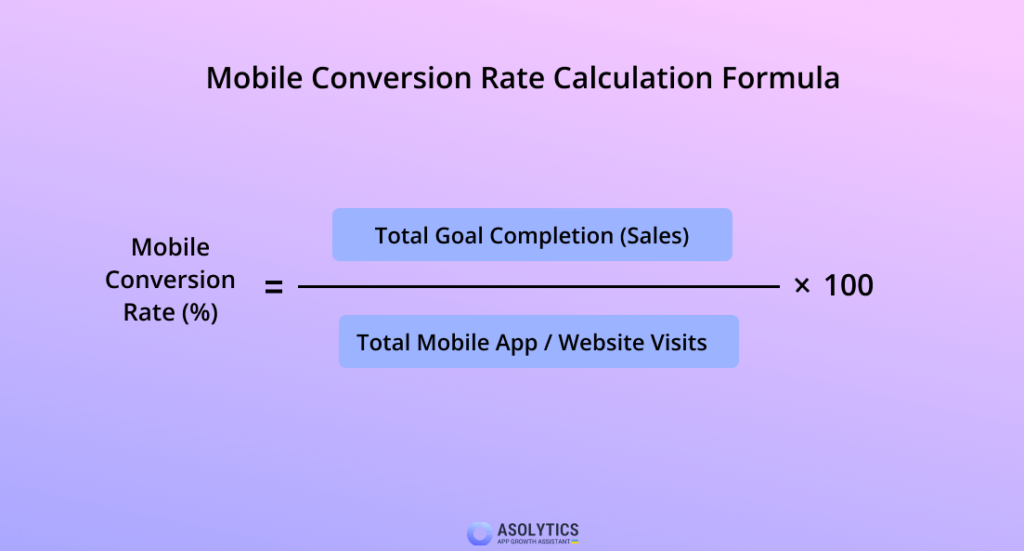
Below, we’ve listed the main specifics of app store conversion rate:
- Conversion Goals. These are predetermined actions or events you want users to complete, often called ‘conversions.’ Each app may have different conversion goals, such as generating revenue, increasing user engagement, or expanding the user base.
- App Conversion Rate Formula. ACR is calculated by dividing the number of users who have completed the desired action (conversions) by the total number of app users during a specific time period.
- Optimization. ACR serves as a critical indicator of app performance. It helps identify areas where user experiences may need improvement, enabling developers and marketers to optimize the app’s design, functionality, and user flow.
- A/B Testing. ACR is a common metric used in A/B testing scenarios, where developers test different app versions to determine which one yields a higher conversion rate.
- Retention. A high ACR can positively influence the app retention rate, as satisfied users are more likely to return to the app and continue engaging with it.
8 Reasons Why App Conversion Rate Is So Important
Users’ app experience is like a road trip — it begins before they even hit the ‘Install’ button! But guess what? The adventure doesn’t stop at the ‘Install’ sign, either. Nope! Once your app users join the app party, the journey continues. Marketers’ task here is steering their target audience toward the big moments, like making cool purchases or signing up for amazing subscriptions.
And trust us, getting your users to reach these milestones is like hitting turbo on your road trip. Traffic jams won’t do the trick. You need people onboard, enjoying the ride and embracing the fun stuff. So, remember, it’s not just about getting them in the car. It’s about taking them to all the best places along the way!
Now, let’s talk numbers. There are app categories where apps will drop over $100 per user to make sure their users are part of their subscription or purchase club. Therefore, the App Conversion Rate isn’t just another tech jargon. It’s the heartbeat of your application’s success. Here are 8 main reasons why ACR is the most valuable player in the app game:
- It boosts user engagement
A high ACR means users actively engage with your app, indicating its relevance and appeal. Think of the app conversion rate as the applause at a live show. It’s when the audience goes from quietly listening to giving a standing ovation. A high app store conversion rate means users aren’t just spectators. They’re active participants, eagerly engaging with your app’s performance. So, make sure your app’s ‘show’ is so captivating that the audience can’t help but join in with unstoppable cheers and applause. - It increases your revenue
Naturally, converting users into paying customers is the primary revenue driver for most apps. Boosting your app’s conversion rate is like turning window shoppers into loyal customers. When more users complete desired actions, such as making purchases or subscribing, your revenue flow mounts, ultimately satisfying rise. - It fosters user retention
When users complete meaningful actions within your app, they’re more likely to stay engaged and loyal. It’s like having a favorite coffee shop where they know the details of your order — you keep coming back because they’ve made you feel valued. High conversion rates create a similar sense of loyalty, signifying that your users genuinely want to stay with your product or services. - It helps you make informed decisions
ACR provides invaluable insights into user behavior. Just like a map helps you choose the best route, conversion rate data analysis allows you to optimize your app’s user experience and tailor your strategies accordingly. - It improves your app store rankings
High app download conversion rate indicates user satisfaction and engagement, which app stores reward with improved visibility. Naturally, a top-ranking app gets more downloads and recognition, creating a virtuous cycle of long-anticipated growth. - It sets you apart from competitors
A stellar app install conversion rate is your unique selling proposition in a crowded marketplace. It showcases your app’s effectiveness, making it the preferred choice for users leaving competitors in the dust. - It contributes to user satisfaction
App conversion rates are the cornerstone of user satisfaction. When users effortlessly achieve their goals within a mobile application, they’re more content. It’s like a restaurant where the food always exceeds expectations — customers leave happy and return for more. - It stimulates growth
App conversion rates are the seeds of growth in your app’s garden. They sprout opportunities for scaling up, just like a successful farmer expanding their fields. A high conversion rate attracts more users and paves the way for sustainable growth as satisfied users become advocates, and your app becomes a force to be reckoned with.
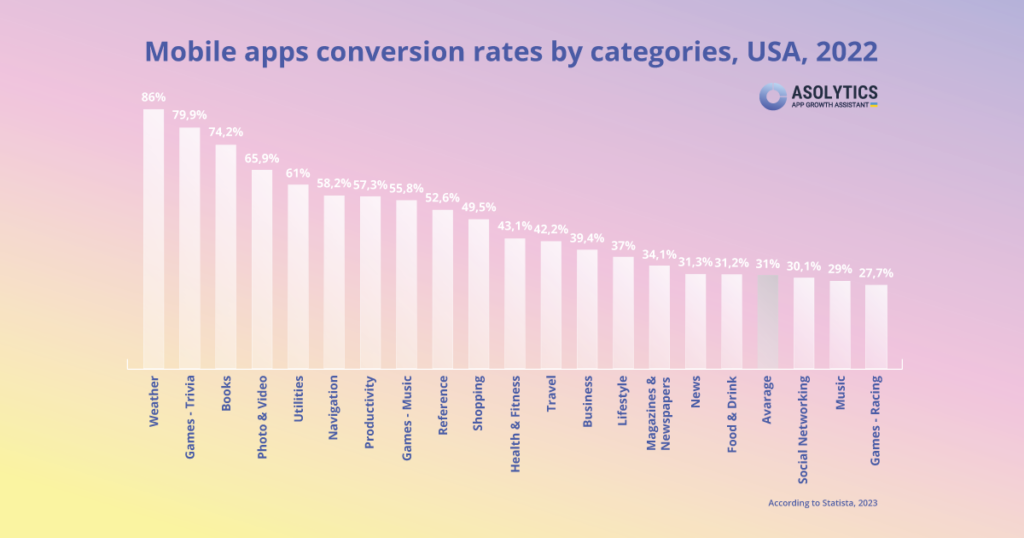
App conversion rates are the seeds of growth in your app’s garden. They sprout opportunities for scaling up, just like a successful farmer expanding their fields. A high conversion rate attracts more users and paves the way for sustainable growth as satisfied users become advocates, and your app becomes a force to be reckoned with.
How to Calculate App Conversion Rate in 6 Steps
Here’s a pretty straightforward step-by-step guide to measuring ACR from our experts:
Step 1. Pinpoint Your Conversion Goals. Identify the specific actions or events that constitute a successful conversion in your app. These goals may include in-app purchases, account sign-ups, or video views.
Step 2. Establish a Time Frame. Determine the time period over which you’ll measure ACR. Common time frames include daily, weekly, or monthly calculations.
Step 3. Collect Data. Make the most of the Asolytics tools to gather data on user actions and app installations.

Step 4. Calculate ACR. Divide the number of users who completed the desired action (conversions) by the total number of app users during the chosen time frame. The basic formula is as follows: ACR = (number of conversions / total number of users) × 100.
Step 5. Interpret the Results. Analyze the calculated ACR to assess user engagement and identify areas for improvement in your app’s user flow and design.
Step 6. Polish and Improve. Based on your findings, adjust your mobile application to optimize the user experience and increase the average app conversion rate.
Simple Example of Measuring ACR
Let’s say you’re in the mobile gaming industry and want to calculate your app store conversion rate. In this context, the conversion rate would involve tracking the number of users who download your game (installs) compared to those who complete an important in-game action, like reaching level 5 or making an in-app purchase.
So, to calculate your mobile app download conversion rate for this specific scenario:
- Determine the time frame. Let’s say you want to assess a month’s performance.
- Collect data. Count the number of installs and the number of users who reached level 5 or made an in-app purchase during that month.
- Calculate the app store conversion rate. Divide the number of users who performed the desired in-game action by the total number of installs, then multiply by 100. For example, if you had 1,000 installs and 200 users reached level 5 or made an in-app purchase: App Conversion Rate = (200 / 1,000) × 100 = 20%
This calculation reveals that 20% of users who installed your game went on to achieve a significant in-game milestone or made a purchase. Not bad! This can help you assess the game’s overall appeal and the effectiveness of your onboarding process.
What Is a Good Conversion Rate?
Regularly measuring and refining your ACR is essential for enhancing user engagement and maximizing the impact of your application. But remember that ACR is an adaptable metric. In fact, a universal app store conversion rate benchmark doesn’t exist, given the multitude of factors at play, such as your industry sector, gadget type, and target geographical location.
To better grasp mobile app conversion classification, let’s delve into 3 common app conversion types: app store conversions, install to in-app events conversion rate, and conversions from installation to purchases.
- App store conversion rates (page view to install)
The average app install conversion rate signifies the proportion of users who, upon visiting an app’s page, proceed to install it—monitoring both the number of views on your application page and the actual installations grants valuable insights into the impact of your content, presentation, and overall impression. This metric helps determine how effectively your app entices users to take that crucial step of installation.
Now, let’s talk about ways to increase your page view to install app conversion rates. These days, when the total combined downloads from the Apple App Store and Google Play reached an estimated 35 billion, competition has soared to unparalleled levels.
For this reason, the cornerstone of improving application visibility and traffic is working up a stellar App Store Optimization strategy, or ASO strategy for short. Below, we’ll provide helpful ASO-based tips to help you increase your page view and install app store conversion rate.
- Create an Eye-Catching Icon and Name There are four integral aspects of an icon that excel:
- Scalability: the icon must maintain its core elements across various contexts, sizes, and settings. Steer clear of overly intricate icons that could prove distracting and indiscernible on smaller screens;
- Recognizability: the icon should create a functional and emotional bond with your primary audience. Avoid uninspiring color palettes and evaluate how your application integrates with other icons on your mobile home screen;
- Uniqueness: the icon should stand out among competitor applications. While it doesn’t have to be entirely one-of-a-kind and can follow prevailing trends, your application must remain easily discoverable. Even a unique color palette can enhance your visibility;
- Wordless-ness: your icon should communicate your app’s identity through visuals. That eliminates the need for clutter caused by unreadable text on it.
In the quest for a name, the fundamental step is to assess your competition to discover a distinctive means of striking a chord with your audience. Capitalize on your unique value, incorporate trending keywords, explore long-tail phrases, or even incorporate playful puns.
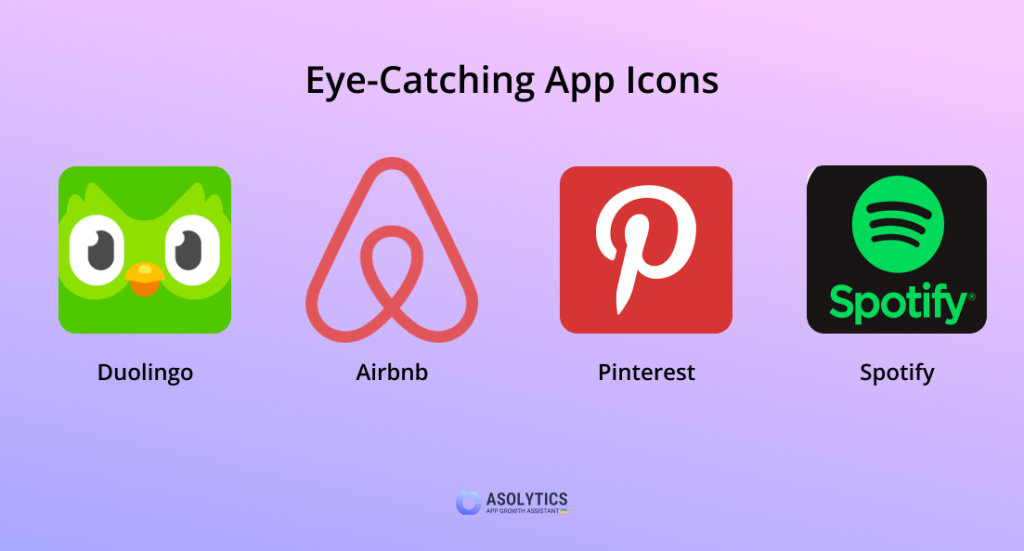
- Compose Captivating App Descriptions Apple grants you 4,000 characters to craft your app description in the App Store. Begin by pinpointing four crucial characteristics of your application:
- your app’s core value;
- reasons why people should download it;
- the problem your application solves;
- how your app enriches users’ daily lives.
With all the essential points at your fingertips, craft an app description that seamlessly weaves this information into a compelling and approachable narrative. Remember, the first three sentences, prominently displayed above the fold, hold the power to captivate the reader and make them need your application (or not!).
- Secure More App Reviews Reviews are a significant factor in ASO rankings and are a substantial symbol of trust, fortifying credibility and spurring installations. Reports indicate that 80% of consumers avoid applications with ratings below 4.0 stars, while an astonishing 90% engage in thorough review reading before proceeding with app installation. Below, we’ve listed some expert tips for securing more reviews:
- Simplify the review process and offer incentives to users who leave feedback.
- Encourage users to leave a review within the app upon hitting a major milestone, achieving a notable goal, or unlocking the app’s core value.
- Conduct a competition on a forum or community platform, allowing participants to win a raffle prize or giveaway as a reward.
- Categorize your email list into segments according to users’ operating system and invite them to provide reviews.
- According to Bill Gates, ‘Your most unhappy customers are your greatest source of learning.’ With the following smart tactic, you’ll use this bittersweet perk to your utmost advantage. Enable users to provide negative feedback and report bugs conveniently within the app. That way, you’ll prevent them from resorting to unfavorable reviews — and washing your dirty linen in public, so to speak.
- React promptly to negative feedback and consistently release bug fixes. Engage with negative reviewers by offering the option to amend their feedback once issues are resolved.
- Install to in-app events conversion rate
Earlier, we explored techniques to boost installations, but it’s evaluating post-installation behaviors that ensure your application drives profit in the long run.
The mobile app environment is experiencing rapid expansion, leading to the prevalence of free applications as a means to acquire new users. The traditional approach of charging users an upfront, one-time fee for mobile app downloads has given way to a new paradigm. These days, marketers prioritize ongoing user engagement to encourage potential purchases. In fact, proficient app marketers master the art of increasing new installations while also methodically measuring installs linked to in-app events, aiming to guide users through the conversion process. And that’s where install to in-app events conversion rate comes into play.
Every app features unique in-app events designed to stimulate positive behaviors. For instance, a fitness app might have an ‘Achievement Unlocked’ event when a user completes a week of consistent workouts, encouraging them to maintain their fitness routine. These events are strategically crafted to boost user engagement and retention
Below, you’ll find expert tips on how to boost your in-app events conversion rate:
- Never Stop Improving User Experience One of our favorite Maya Angelou quotes has always been: ‘I’ve learned that people will forget what you said, people will forget what you did, but people will never forget how you made them feel.’ You can effectively use this as a powerful reminder to make your users feel content and convenient when navigating your app.
Begin by tackling the critical pain points that users face in reaching the app’s first value milestone. For instance, if the first major moment is when a user logs their first week of workouts, the journey from installation to achieving this milestone must be effortless. Reduce the registration process to a minimum, simplify the onboarding experience, and emphasize core fitness features from the outset. This ensures that users can seamlessly transition into their fitness routine and perceive the application’s value immediately, driving engagement and retention. - Regularly Run Split Tests on Everything Utilize split testing (also known as A/B testing) to compare different software variations and determine the most effective one. Every aspect is testable, including in-app content, articles, wireframes, button shades, and visuals. Bear in mind that numbers are the ultimate truth-tellers.
- Outline the Steps in Your App’s Conversion Funnel This strategy provides a clear roadmap to identify bottlenecks, optimize user flow, and enhance user experience, ultimately leading to higher conversion rates.
- Encourage Current Users to Launch Your App Using Deep Linking After installing an app, many users may not engage actively. That said, if a user stays inactive for 30 days, marketers can implement a re-engagement approach, encouraging users to open the app for particular actions. You can accomplish this via a push notification, email, or text message with a deep link that instantly launches the application to the most relevant page.
- Install to purchase conversion rate
The in app purchase conversion rate measures the percentage of installations that result in in-app purchases. This ACR type focuses solely on revenue-related actions. Interestingly, North American consumers demonstrate impressive install-to-buyer ratios, with iOS leading at 2.25% and Android not far behind, with the second-highest ratio at 1.3%.
If you want to boost your in-app purchase conversion rate, refine your mobile checkout flow. Here are some useful tips from our experts on exactly how to do it:
- Declutter and minimize distractions. Keep your calls-to-action straightforward and consider ditching pop-up messages.
- Speed up the checkout process by automatically filling in fields.
- Foster trust and security by incorporating trust symbols, such as ‘Guaranteed Safe Checkout’ or ‘Free Shipping on All Orders’ badges. Incorporate 3rd-party endorsements such as BBB badges, Google Reviews, accepted payment methods, and extended validation SSL certificates.
- Provide flexibility by not enforcing registration and enabling new users to buy as guests.
- Prioritize speed in your checkout process for customer satisfaction.
Did you know that almost half of shoppers who progress from the cart to the checkout page still refrain from making a purchase? That said, another tip for bolstering your conversion rate mobile app is to minimize cart abandonment by re-establishing contact with abandoners. Here are 4 possible reasons behind users’ reluctance to complete their checkout:
- Concealed charges and exorbitant shipping expenses.
- Mandatory registration, excessive fields, or an overwhelming number of steps.
- Concerns regarding your mobile application privacy and speed.
- Limited payment choices and inadequate bank connections.
To improve the situation, reconnect with your cart-abandoning ‘runaway buyers.’ Explore sending them a purchase completion email featuring dynamic visuals and compelling calls-to-action. Additionally, you can tempt users with a limited-time discount push notification, softly guiding them closer to the finish line.
Last but not least, boost your conversion rate app to the install-to-purchase level by showcasing the value of in-app purchases. This is especially crucial for mobile games. When selling digital currency for unlocking in-game bonuses or power-ups, it’s crucial to transparently demonstrate their value. Offer new users a preview of in-app purchase worth by granting free bonuses at the very start.
Uninstall Conversion Rate: a Key Indicator of App Health
Uninstall App Conversion Rate, or churn rate, is the percentage of users who uninstall or remove an application from their device after initially installing it. It measures the app’s ability to retain users and reflects how they disengage or find the app unsatisfactory. A high uninstall rate affects retention and increases customer acquisition costs.
Follow these steps to calculate the uninstall conversion rate:
- Collect Data Gather data on the number of application uninstalls within a specific timeframe.
- Determine Installs Obtain the total number of installs during the same period.
- Calculate Rate Divide the number of uninstalls by the total installs.
- Multiply by 100 Multiply it by 100 to present it as a percentage. The formula looks like this: Uninstall App Conversion Rate (%) = (uninstalls / installs) * 100.
This percentage reveals the proportion of users who decided to uninstall your application, helping you assess its appeal and functionality.
Users may uninstall your app for various reasons, impacting your Uninstall Conversion Rate. Common factors include:
- Poor Performance. Software that lags, crashes, or consumes excessive resources frustrates users.
- Annoying Ads. Excessive or invasive advertising disrupts the user experience.
- Limited Features. Applications with limited functionality or outdated features lose appeal.
- Large Storage Size. Users may remove apps consuming too much device storage.
- Complex Navigation. Complicated interfaces or unclear navigation frustrate users.
- Privacy Concerns. Users uninstall apps that raise privacy or security concerns.
- High Battery Usage. Applications draining battery life quickly are often uninstalled.
- Lack of Updates. Rare updates may result in compatibility issues or a lack of new content.
- Better Alternatives. Users switch to similar mobile apps offering superior experiences.
- Unwanted Notifications. Applications bombarding users with irrelevant notifications can lead to uninstalls.
Now that you understand these factors, you can work effectively towards reducing uninstall rates and retaining satisfied users. Regularly analyzing user feedback and updating your app accordingly can significantly reduce your Uninstall Conversion Rate.
The Game-Changer: Install to Value Conversion
The Install to Value conversion rate is the crucial metric that distinguishes the success of a mobile app. Unlike other conversion rates that merely measure user actions, Install to Value delves deeper into the app’s ability to turn downloads into tangible worth. Here are the perks this conversion type comes with:
- Real ROI Measurement. Install to Value provides a concrete measurement of return on investment (ROI). It quantifies how many users who installed the app progressed to a stage where they generated value, such as purchasing or subscribing.
- User Engagement. It gauges the app’s ability to engage users effectively. High Install to Value rates indicate that users are not just installing the app but are actively participating and deriving value from it.
- Monetization. For apps aiming to generate revenue, this metric is indispensable. It measures how well the application converts users into paying customers, making it a direct indicator of profitability.
- Customer Lifetime Value (CLV). Install to Value directly influences CLV. Users who derive value from the app are more likely to remain engaged over time, increasing their long-term value to the application.
- App Optimization. Tracking Install to Value guides app developers and marketers in optimizing various aspects, from onboarding to user experience, ensuring that users are led to the point of generating value.
- Competitive Edge. In a competitive mobile marketplace, having a high Install to Value rate sets an app apart. It signifies that the application doesn’t just attract users but retains and monetizes them effectively.
- User Satisfaction. When users find value in an app, they are more likely to leave positive reviews and recommendations, further enhancing an app’s reputation and attracting more users.
As the quote by Janice H. Reinold goes, ‘In today’s modern world, people are either asleep or connected.’ Reap the ultimate benefit of this ever-evolving trend to make your users feel happy and fulfilled while connecting to your application nonstop. Go the extra mile to nurture relationships with subscribers, deliver ongoing value, and continuously improve user experience. By doing so, you are guaranteed to elevate your revenue to the next level, enhance brand loyalty, and establish a thriving user community that benefits your software and its users.
Measuring Install to Value Conversion: Step-By-Step Guide
Follow these 10 vital steps to calculate install to value app conversion rate:
- Start by identifying what constitutes ‘value’ within your app. It could be a purchase, subscription, completing a specific level, or any action that aligns with your app’s goals.
- Utilize Asolytics apps analysis tools to monitor the number of app installations over a specific period.
- Determine the actions indicating a user has achieved ‘value.’ This could be making a purchase, reaching a certain level, or spending a predefined amount of time in the app.
- Categorize users based on their actions within the app. Segmenting lets you see which user groups are most effectively converting installations into value.
- Divide the number of users who have achieved the ‘value’ action by the total number of app installations. Express it as a percentage by multiplying the result by 100.
- Continuously monitor the Install to Value conversion rate and analyze it over time. Identify bottlenecks or drop-off points in the user journey and make necessary improvements.
- Experiment with different onboarding processes, user interfaces, and incentives to improve the conversion rate. A/B testing can help you identify which strategies work best.
- Collect feedback from users who didn’t convert to understand their pain points and reasons for not reaching the ‘value’ stage. Use this feedback to refine your app’s user experience.
- Benchmark your Install to Value conversion rate against industry standards to assess your app’s performance relative to competitors.
- Refine your marketing strategies to attract users more likely to convert into valuable actions, ensuring a higher Install to Value conversion rate.
With regard to industry standards for the Install to Value app conversion rate, they can vary significantly depending on factors such as the mobile app’s category, target audience, and the nature of the app’s value proposition. However, as a general guideline, an Install to Value app conversion rate of 20% or higher is considered excellent. This means that out of every 100 users who install the app, at least 20 go on to take valuable actions within the app, such as making a purchase or subscribing.
10 More Tips for Boosting Your Mobile App Conversion Rate
Here are some more actionable and practical tips for you to make the most of ACR bolstering-wise:
- Enhance the app’s initial appeal
A mobile app’s conversion rate is naturally connected to users’ first impressions on the Play Store and App Store during installation or usage. In the first moments of engagement, you can inform users about your app’s functionality and motivate them to either proceed with the download or abandon the installation. As you contemplate optimization, think about your initial experience and expectations when interacting with an app on the store.
To succeed, channel your optimization efforts toward the most prominent marketing assets within the First Impressions Frame of each app store. When optimizing for Google Play, place a strong emphasis on enhancing the Feature Graphic. When targeting the Apple App Store, prioritize the optimization of your first impressions Gallery. - Apply user segmentation
If your app doesn’t target a specific niche or audience group, you can create dedicated sections for different user personas with diverse interests. This approach allows you to swiftly comprehend the distinct needs of diverse target audiences, retaining their free membership and eventually converting them into paying customers.
Divide your app users into segments and craft unique strategies for each segment. Use the risk of churn as a criterion for categorization and implement diverse conversion techniques accordingly. Adjust your campaigns to evaluate each segment’s performance, contributing to enhancing your mobile app’s conversion rate. - Boost mobile application speed
Mobile users are more impatient in comparison to their desktop counterparts. App load times should ideally fall within the 1-2 second range. According to 70% of consumers, page speed affects their purchase choices. Slow-loading apps (both desktop and mobile) risk losing customers to competitors. With that said, do your absolute best to elevate your mobile conversion app rates by prioritizing app speed.
Here are some expert recommendations for boosting your application’s loading speed:
- Compress and resize images to reduce their file size, improving loading times.
- Combine CSS and JavaScript files to minimize the number of requests necessary for page loading.
- Store frequently used resources locally to speed up subsequent visits.
- Distribute content across multiple servers to reduce server load and enhance speed.
- Reduce server response time by optimizing its performance and using speedier hosting services.
- Create lightweight versions of pages for quicker mobile loading.
- Regularly analyze loading performance and make necessary adjustments to maintain speed and user satisfaction.
- Tailor your app for each platform
For apps accessible on multiple platforms, it’s crucial to cater to each platform’s unique requirements and user expectations. The primary platforms, Google Play Store and Apple App Store differ in design, marketing approaches, and resources. By meticulously addressing these distinctions, you can effectively engage Android and iOS users, ultimately amplifying your mobile app’s conversion rate. - Don’t neglect localization & culturalization
The internet and technological progress have accelerated globalization, bridging gaps between geographically distant areas. Nonetheless, it’s crucial to acknowledge the distinctions in these areas, particularly the varied nature of potential global clientele. Tailoring your approach for users in one country doesn’t necessarily yield the same outcomes as applying the same conversion tactics to users from an entirely different region or nation.
When implementing mobile app marketing practices, don’t overlook the importance of regional marketing. Take the initiative to translate your app and its functionalities into the native languages of various countries while tailoring them to align with the cultural intricacies of each region.
Take Spotify, for instance. To infuse a cultural touch for every audience, they employ a clever tactic — featuring in their app screenshots the top artists from the countries based on their users’ location. That’s what we call smart screenshot culturalization!
Culturalization enhances the relevance of your messages, encouraging greater engagement with your mobile app and thus positively impacting its conversion rate. Yet, make sure you tread lightly into this territory. Conduct comprehensive research to grasp even the subtlest cultural nuances to avoid unintentional missteps. - Make the most of retargeting
Retargeting, often referred to as remarketing, is a digital advertising tactic designed to maintain brand exposure to individuals who have departed from your website or app without converting. It is a valuable tool, enabling businesses to reconnect with the 98% of users who didn’t take immediate action.
Retargeting relies on cookie-based technology, employing unobtrusive JavaScript code to discreetly track your website visitors as they navigate the internet. This sophisticated tool holds substantial potential for enhancing both brand visibility and conversion rates, particularly when integrated seamlessly with outbound and inbound marketing efforts.
Retargeting serves as a means to establish a persistent presence in the minds of your app’s visitors, subtly rekindling their interest whenever they roam beyond your app’s boundaries. Gradually, this approach can successfully stimulate them to reengage with your offerings, prompting a second look that may culminate in conversions. - Send push notifications matching your users’ needs
Push notifications work as a powerful tool for getting to grips with the motivations of your mobile app users. After categorizing your audience into risk-level groups to amplify your conversion rate, it’s essential to craft tailored strategies for each segmented user cluster.
After this, send push notifications catering to each user cluster’s unique needs and anticipations to drive conversions. Irrelevant push notifications tend to go unnoticed. That said, sending a push notification corresponding to the user’s purpose, needs, and preferences is a proven approach to seizing their attention. Offering tailored, exclusive promotions via push notifications captivates the user and heightens the likelihood of conversion.
Avoid making your push or in-app notifications overly aggressive and sales-focused. Pushing too hard with popup alerts can lead your target audience to uninstall your app, ultimately diminishing your mobile app conversion rate. - Feature relevant and meaningful ads
Ads play a vital role in app revenue, yet they can be bothersome to users, leading to disinterest. When pillaging mobile apps, users encounter a multitude of ads. To engage users effectively, ads must offer value and relevance.
Capitalize on this chance by displaying meaningful and valuable ads to your audience. Conduct a comprehensive analysis of your audience and ad content. Then, allocate resources to the ad formats that are most appealing to them. Building a connection through ads can greatly enhance conversion and purchase rates. - Optimize CTA button visibility on your app
Effective app design shapes user decisions, directing them toward the desired goal. The Call-to-Action (CTA) button boosts the chances of achieving your app’s goal, whether increasing sales or delivering valuable information.
The CTA button holds immense importance in guiding traffic toward the desired landing page and assisting apps in elevating their conversion rates. You have just one line to pitch your app and product, which is the entire window of opportunity to convert a potential customer.
To optimize your CTA button, consider enlarging it to grab users’ attention. You can also experiment with a somewhat unconventional color and design but avoid anything too distracting. - Make sure there are no repetitive messages
Repetitive mobile app content can have a negative impact on user engagement and conversion rates. When users encounter the same message multiple times, they may believe there’s no additional value to be found and navigate away from your app page promptly. To maintain their interest and boost conversions, make sure each page presents fresh and engaging content. - Fully embrace trend-following
Customers appreciate relatable interactions. By tapping into trends your customers resonate with and thus speaking your audience’s language, you can build trust and boost brand recognition. That said, always go the extra mile to stay updated on trends relevant to your audience’s preferences.
BONUS TIP. Infuse your app content with subtle psychological triggers. Oh yes, this one is smart!
Due to mobile users’ brief attention spans and restricted screen space, eCommerce businesses are compelled to promptly steer customers toward their desired actions. But the question is, how can you achieve this? That’s where psychological triggers kick in.
After extensive analysis, the Asolytics team has identified urgency and scarcity as the primary psychological triggers that effectively prompt online shoppers to take immediate action. The fear of missing out on something valuable is the driving force behind immediate action.
To engage customers effectively, consider these tactics:
- Incorporate tags like ‘trending now’ or ‘fast-selling’ for popular products.
- Feature real-time sales notifications and reveal the number of current product viewers.
Invest in the absolute subtleness of these triggers and prevent them from disrupting the users’ mobile browsing experience.
In Conclusion
Getting the gist of app conversion rates is paramount. As John Munsell, an experienced technologist and marketer, once said, ‘If content is king, then conversion is queen.’ And that’s an undeniable fact!
First impressions matter, so optimize your app’s store presence to stand out. Segmentation and retargeting strategies keep users engaged. Personalized push notifications nudge them in the right direction, and meaningful ads make the experience smoother.
Fast loading times are non-negotiable — users are impatient! And remember, trends matter. Stay updated with what’s hot and make the best out of psychological triggers like urgency and scarcity.
To sum it all up, in the words of marketing legend Seth Godin: ‘Don’t find customers for your products; find products for your customers.’ Tailor your mobile app to user needs, and you’ll rule the conversion game.
So, keep these nuggets of wisdom in your back pocket, and go forth to conquer the world of mobile app conversion rates.
FAQ
What is the mobile app conversion rate?
The mobile app conversion rate is the percentage of users who take a specific action within a mobile app. This action can range from installing the app, making a purchase, subscribing, or any other valuable interaction that resonates with the app’s goals. It’s a crucial metric for app performance analysis.
Why is everyone suddenly so interested in increasing their app conversion rates?
The surge in interest in boosting app conversion rates is driven by the exponential growth of mobile app usage and eCommerce. Businesses now recognize the immense potential in converting mobile users into customers, making it essential to optimize conversion rates to stay competitive and profitable on the digital scene.
Why is ACR important?
App Conversion Rate is vital because it measures an app’s ability to turn users into customers or engaged users. A high ACR indicates effective user journeys and value propositions, while a low one signifies potential problems. Tracking ACR helps developers and marketers get the full picture of user behavior, optimize the app experience, and maximize revenue through improved conversions and user retention strategies.
What is the classification of app conversion rates?
There are various types of app conversion rates, the main of which are install to first open, event conversion rate, purchase conversion rate, subscription conversion rate, and uninstall conversion rate.
How do I calculate app conversion rate?
Divide the number of desired user actions (such as installations, purchases, or sign-ups) by the total number of users who could take that action. To show it as a percentage, just multiply the resulting number by 100. This formula provides insights into the effectiveness of your app’s conversion funnel.
What is a good app store conversion rate?
A good app store conversion rate can vary but generally falls between 15% and 30%. However, the average app store conversion rate depends on the app category and audience. Monitoring and improving this rate over time is crucial for app profitability.
What are the specifics of a mobile app free to premium conversion rate?
Also known as app subscription conversion rate, it measures the percentage of users who transition from utilizing a free version of an app to a premium (paid) version. It reflects the app’s ability to convince users to upgrade and access advanced features or an ad-free experience.
What are the common challenges faced in app conversion?
Common challenges include complex registration processes, poor user interface design, slow loading times, a lack of trust due to inadequate security measures, and unclear privacy policies. Additionally, apps that fail to communicate their value proposition clearly may struggle with conversion, as users need a compelling reason to engage and continue using the app.
How can I improve my app conversion rate?
Start by refining your app’s onboarding experience, making it user-friendly and engaging. Implement A/B testing to identify what resonates with users best and make the best out of customer feedback to address pain points. Adjust your marketing strategies to attract high-quality users and continually analyze data to make fact-backed improvements.
What is the role of A/B testing in improving app conversion rates?
A/B testing (split testing) allows developers to compare different app variations to identify what resonates best with users. It stimulates data-backed decisions, fine-tuning elements like design, content, and features to optimize the user experience and ultimately skyrocket conversion rates to stardom.
What role does ASO play in improving ACR?
App Store Optimization significantly impacts ACR by enhancing an app’s visibility, ranking, and discoverability within app stores. It involves optimizing keywords, metadata, and visuals to attract more relevant users. This, in turn, ultimately influences the conversion rate app store and improves ACR.
How does the user interface and user experience impact app conversion?
A well-designed, intuitive user interface and a positive user experience make users more likely to engage, convert, and remain loyal. Conversely, a confusing or frustrating user interface/user experience can deter users, leading to lower conversion rates and higher uninstallation rates.
How can I track and analyze user behavior to optimize conversions?
Tracking and analyzing user behavior for optimizing conversions is made efficient with tools like Asolytics. It provides valuable insights into keyword rankings, app performance, and user reviews. By monitoring these metrics, you can make informed decisions and continually improve your app to boost conversions.
How can I reduce cart abandonment and improve conversion?
Two words: checkout optimization. Simplify forms, provide multiple payment options, offer clear shipping information, and use trust symbols. Minimize distractions, like pop-ups, and implement retargeting strategies, including email reminders and limited-time discounts, to re-engage potential customers and encourage them to complete their purchases.
What are some effective re-engagement strategies for increasing app conversion?
Personalized push notifications, in-app messages, and email campaigns. Tailoring your messages to user preferences and behaviors can reignite their interest in the app, encouraging them to return and complete desired actions.
What are the industry standards for app conversion rates across different categories?
Industry standards for app conversion rates vary across categories. While there’s no one-size-fits-all benchmark, e-commerce and gaming apps tend to have higher install conversion rates, with e-commerce often exceeding 5%. Utility apps may see lower rates around 1-2%. The specific category and user behavior heavily influence these standards.
What are the examples of culturalization in the context of boosting your mobile app conversions?
Culturalization can involve tailoring content, visuals, and promotions to align with specific cultural preferences. Aside from the Spotify example provided above, on a broader scale, it can include showcasing regional holidays and incorporating culturally relevant symbols. These strategies connect with users on a personal level, fostering trust and increasing the likelihood of conversion.

